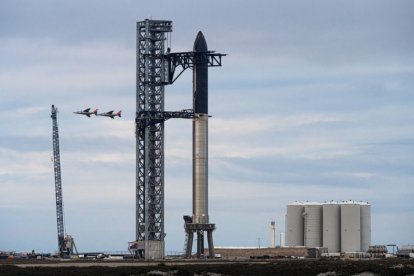SpaceX to send four civilians on private space exploration for the first time
The Polaris Dawn mission is scheduled for liftoff on Aug. 26, 2024, and will be a five-day trip around Earth.

SpaceX's Starship rocket
In just a few days, SpaceX will carry out a launch that promises to mark a before and after in space exploration. The Polaris Dawn mission, scheduled for liftoff on Aug. 26, 2024, will send four civilian astronauts on a five-day journey around Earth, during which they will attempt the first spacewalk on a nongovernmental mission.
Innovation and technical challenges on the Polaris Dawn mission.
The Polaris Dawn team, composed of entrepreneur Jared Isaacman as commander, along with Sarah Gillis, Anna Menon, and Scott "Kidd" Poteet, has undergone rigorous training that includes simulations in zero gravity, skydiving, and climbing in extreme environments. This extensive training is critical to prepare the crew for one of the mission's most ambitious challenges: an unprecedented spacewalk.
Unlike traditional missions, SpaceX's Crew Dragon spacecraft, which will serve as the vehicle on Polaris Dawn, does not have a dedicated airlock. Therefore, the crew must fully depressurize the cabin before exiting into the vacuum of space, a complex process that requires precision and state-of-the-art spacesuits. SpaceX has meticulously developed and tested these suits to ensure they can withstand the harsh conditions of the space environment, ensuring the safety of the astronauts during the walk.
A focus on scientific research and technological innovation
In addition to the historic private spacewalk, Polaris Dawn is focused on human health research in space, a crucial aspect for future missions beyond Earth's orbit. The mission will cross the Van Allen radiation belts, an area of high radiation that offers a unique opportunity to study the effects of this environment on humans. The data obtained will be essential for designing new protective measures for astronauts on future missions to destinations such as Mars.
Another innovative component of Polaris Dawn is its role as a testbed for advanced communication technologies. The mission will use SpaceX's Starlink satellite network to test laser communication systems, a technology that could revolutionize the way future interplanetary missions stay in contact with Earth. This enhanced communication capability will be vital to ensuring the success and safety of longer and more distant missions in the future.
Safety is priority
SpaceX has implemented exhaustive safety measuresfor Polaris Dawn, ensuring that every component of the mission can withstand the most extreme conditions. From the Crew Dragon capsule avionics to the construction materials, all elements have been rigorously tested to ensure they can withstand both space radiation and the vacuum of space. This focus on safety underscores SpaceX's commitment to protecting its crew on this pioneering journey.
RECOMMENDATION





















